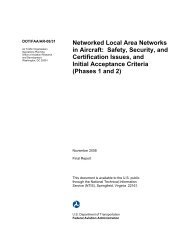Spark Ignition Aircraft Engine Endurance Test of Aviation ... - FAA
Spark Ignition Aircraft Engine Endurance Test of Aviation ... - FAA
Spark Ignition Aircraft Engine Endurance Test of Aviation ... - FAA
Create successful ePaper yourself
Turn your PDF publications into a flip-book with our unique Google optimized e-Paper software.
The engine was measured before and after the endurance test. All fuel was used from sealed<br />
drums containing less than 0.2% water. The entire endurance test was performed at best power<br />
fuel mixtures.<br />
Periodic engine lubricating oil analyses showed that neither fuel dilution nor oil degradation had<br />
occurred. The acid number <strong>of</strong> the oil remained low and showed a level trend, as did the change<br />
in oil viscosity and metals concentration. The test was run at mixture settings leaned to best<br />
power. Running at higher mixtures, which is typical with ethanol-based fuels, may have resulted<br />
in higher oil dilution rates and potentially accelerated wear.<br />
There was minimal engine varnish and sludge buildup, and the combustion chambers had<br />
minimal deposits. The intake valves showed light deposits as did the piston face and ring<br />
grooves. There were minimal fuel system deposits.<br />
The total exhaust valve recession was found to average 0.01875 inch with a maximum value <strong>of</strong><br />
0.0210 inch. Based on previous experience, this was slightly higher than expected. The exhaust<br />
valves exhibited a hammered effect, with the valve faces showing compression grooves. Some<br />
<strong>of</strong> this was due to operation <strong>of</strong> the engine at 5° retarded ignition timing for AGE-85. This<br />
suggests that necessary modifications to ignition timing for operation on AGE-85 may result in<br />
elevated EGTs and accelerated exhaust valve wear.<br />
<strong>Engine</strong> cylinder compressions remained high at the end <strong>of</strong> the test.<br />
It should be noted that performing this endurance test with ethanol containing greater than 1%<br />
water and at fuel mixtures richer than best power may result in much greater engine wear than<br />
was found under the conditions <strong>of</strong> this test. In fact, independent industry data has shown this.<br />
This test showed that without significant modifications to existing engine design beyond<br />
retarding the ignition timing (such as increasing cylinder compression ratios, changing valve<br />
timing, and derating <strong>of</strong> engine power), adjustments to the fuel schedule for a 100- or 100LLcertificated<br />
engine for operation in AGE-85 would be required to provide upwards <strong>of</strong> 57% more<br />
fuel mass flow or 35% more fuel volume flow<br />
.<br />
Current investigation at the Airport and <strong>Aircraft</strong> Safety Research and Development Division at<br />
the <strong>FAA</strong> William J. Hughes Technical Center will include detonation performance studies<br />
comparing AGE-85 to 100LL. This testing will be performed on a 100- or 100LL-certificated<br />
engine at the standard ignition timing. This will address whether typical mixture leaning<br />
operations to best power and best economy can be performed free <strong>of</strong> detonation on AGE-85.<br />
It should also be noted that there is currently no ASTM standard specification for AGE-85. The<br />
formulation tested consisted <strong>of</strong> 85% denatured ethanol, less than 1% biodiesel, and the rest was a<br />
pentane isomerate. Current ethanol research shows the composition <strong>of</strong> AGE-85 to be in<br />
continuous flux, with new proposals eliminating the lubricity-enhancing and corrosion-inhibiting<br />
biodiesel and adding toluene. Future proposals also include eliminating automotive fuel as a<br />
denaturant and seeking approval to use isopentane as the denaturant.<br />
43

















